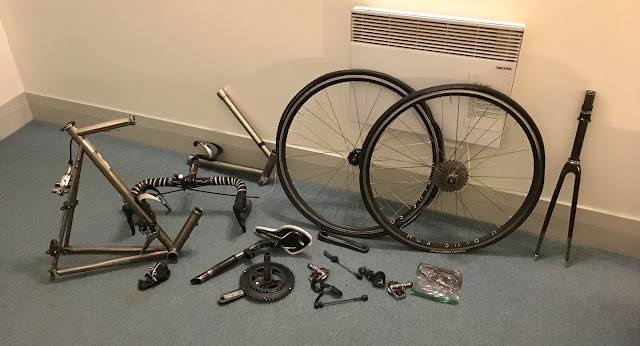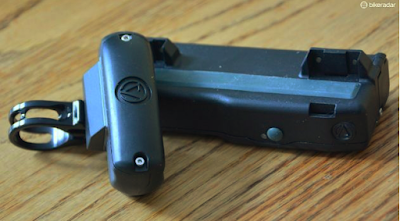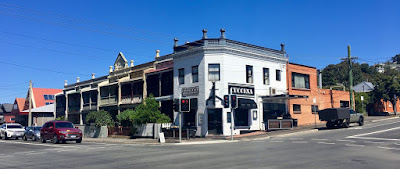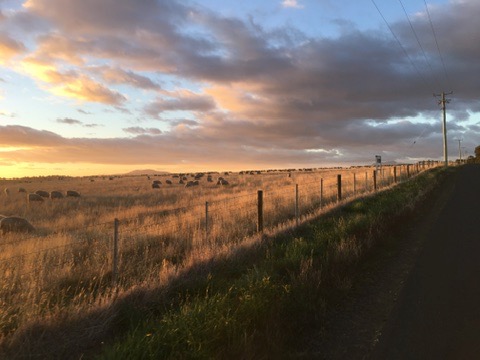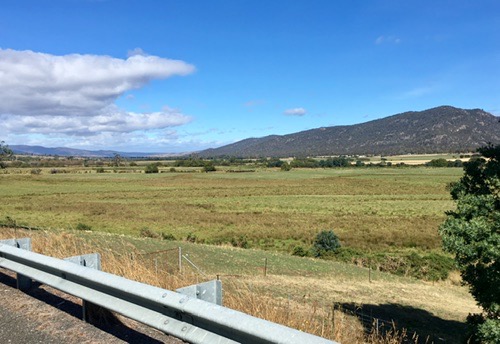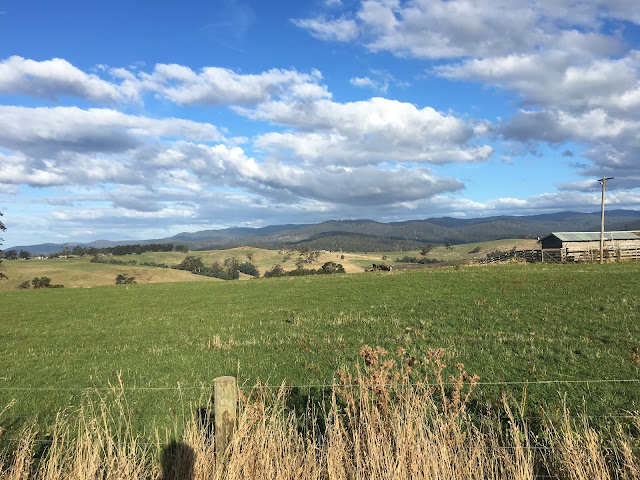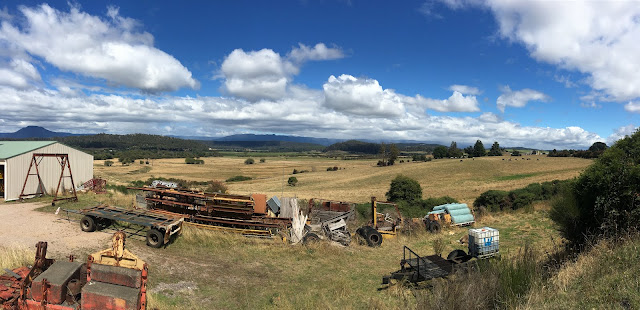I slept early and long, but not deeply, and woke well before my planned 4:15AM alarm on February 24. I ate a very simple jam & toast breakfast (and savored my last individual serving of espresso coffee-in-a-tea-bag). My luggage packed, sunscreen slathered on, bike ready, and I was out in front of our backpacker hostel at 4:50AM ready to go. This is a serious ride, and I prepared in that spirit. It is the big one. ... oh, and not many photos this time. Focus on the goal.
I pull on my brake levers to stop the bike after riding around in the street in front of the hotel, and feel a "thwamp" from the rear wheel and a pulsing sensation through the brake lever. Upon inspection, I have a crack in my rear rim. I point it out to the organizers in the hope someone might just might have a spare rear wheel ... maybe even one with an 11 speed cassette already on it. No such luck. I would just have to ride and hope the wheel holds up. And avoid the rear brake as much as possible. This approach would not be possible in a race or similar event, but in Audax, I think I could make it, safely. I have fresh brake pads on my front wheel's brake, and the weather would be dry the entire ride, so no reason to think otherwise. I am still more worried about getting up the hills than getting down them.
We start this ride in a group as we had leaving Hobart, with one of the faster local riders setting the pace as we take a relatively major road to climb out of Launceston. There is little traffic at 5AM, but it is nonetheless nice to get a start in the group.
Having made it up the first hill together, I hung on to the lead group for awhile, always eager to get a fast start. The pace was a bit stressful, but I manage to at least suck their wheels and hang on. After a half hour or more of this, I feel confident enough to stay in the line with them and work my way up as they rotate. I figure I would get one pull at the front to repay them for their work, then drop off. But I had not counted on James Nitis. James had been the fastest rider in each of the earlier rides, no contest. And he is ahead of me as I work my way toward the front in the rotation. But once he starts his pull the pace accelerates. I am quickly winded and in pain, and I wave another rider past.
Just after Westbury there is a dip down across the river, and a climb up the other side that I remember from our rides toward and away from Deloraine. I relax and let go, knowing that to push hard further and try to stay with the fast boys any longer would risk trouble later in the day. I am still making great time. By 7AM I am already 50 kms into the ride and past our Deloraine lodgings at 300 meters elevation. From 55 to 75km there is even some downhill as we lose most of the elevation gained to Deloraine. 75kms in 3 hours -- a good pace for Audax. I even pass a number of riders from the lead group somewhere ... only notice it when the pass me again. I guess they stopped to remove clothing? Then we get some really nasty hills on a secondary road as we climb again to nearly 300m elevation, and then ride into Sheffield at 87km and the first control for breakfast. I try not to dawdle, but of course, many riders come in while I am eating, pretty much the rest of the group.
From Sheffield we climb up, then plunge down to a river crossing, then climb up the other side of the steep valley. This climb, from 133m to over 700m elevation, takes us onto the central highlands. From here we are "up" and will spend the next three hours between 700 and 900 meters elevation. I make it to the Cradle Mountain Lodge control in good time, order another grilled sandwich "to go", eat half and take half in my rear middle jersey pocket. Mark/Kevin/Catherine arrive, as usual, while I am in the control, and as I head back down from the lodge to the main road I see Rick, Tim Taylor and others coming in.
 |
| Looking back at Cradle Mountain after a short, unshaded nasty climb |
 |
| Near Tullah, denser vegetation in the west |
Surely the ride will get easier, now that we have reached our high point for the first day? Unfortunately, no. There is a lot of up and down on the next stretch, and it is getting warm, and the wind is more in front than anywhere else. There is one painful climb over the edge of a bowl, with the reward being a look back at Cradle Mountain. Finally, I see a live echidna just off the road. It must see me as well, since it goes into a defensive spiny crouch. I don't stop for a photo ... regretting it soon after, but not soon enough to go back. Then I make the left turn onto Murchison Highway. 170kms done so far, and heading downhill! Actually, there were soaring descents and then ugly climbs on this stretch. But I could not fully enjoy the descents, fatigue showing, a bit worried about my rear wheel rim (which seemed to be holding up fine), and with just enough trucks on the road to require care and riding when possible on the shoulder.
 |
| Finally, between Zeehan and Strahan, we see the western sea. Southern Ocean? |
After 10 hours, at 195km, I pull off in Tullah to use a public restroom and get some water. I end up resting, lying on a bench in the shade under a canopy, for 15+ minutes. Time well-spent, but I am away from the road far enough so I do not notice riders passing me. Tara pulls in as I am about to leave. Just after I get going, a few hundred meters up the road, one of the volunteer cars has pulled off and is serving out water by a cafe. Ahhh, I should have stopped there instead. Anyway, too late now. I push on and, only a few km further, start a 300+m elevation climb on a road with no real shoulders, plenty of mid-afternoon traffic, and a 9-10-11% grade. Ouch. More nasty smaller "bumps", then through the mining town of Roseberry, and, mercifully, a flatter stretch and a tailwind for the final 5-10km into Zeehan. Zeehan looks noticeably more downtrodden than the other towns we have seen. It is isolated, seems home to miners and other workers, or maybe it is just the hot, dusty afternoon or my condition that makes it seem a bit worse for wear.
From Zeehan the route continues south, with a relatively favorable wind and not much up or down, so I get to Strahan by 745PM. Many riders are in the control. From Strahan we need to do an extra 12 km "6km out and 6km back" again, to compensate for another course change that brought the total below 600km. I pass Mark, Catherine and Kevin outbound on their 12km on my way into Strahan and again inbound as I head back out for my 12km. At Fred's and Errol's suggestion, I order dinner before doing the extra 12 km (chicken burger), and my food is waiting when I get back.
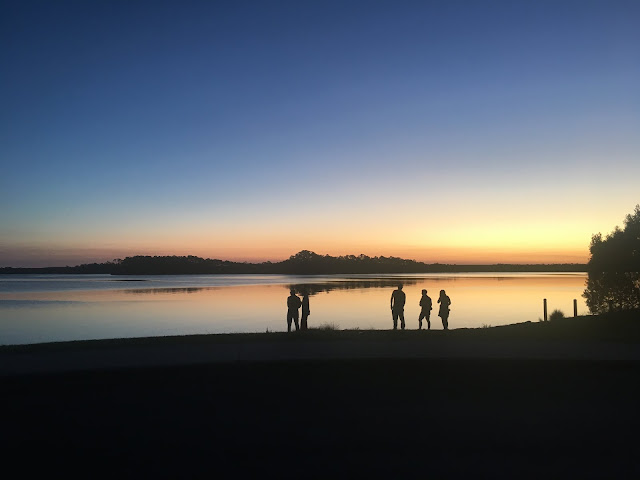 |
| Sunset at Macquarie Harbor |
I leave Strahan at 840PM, only a few minutes behind Mark, Kevin and Catherine. I snap one photo of the sunset over Macquarie Harbor, and head uphill toward Queenstown and our motel. The road is very dark. No more full moon, no more moon at all until the wee hours, and I seem to be riding through a dense forest now. Over the first hour only a couple vehicles pass, including a public bus. If I had known how dark and deserted this road would be, I might have left with the group, even at the expense of some rest. I finally come out on top of a rise, heading north. Suddenly in an exposed section, a gust of wind hits me and nearly knocks me down. But it is no gust. I push forward slowly, the wind continuing. It only lets up after I turn a corner and get into the lee of a hill.
The rest of the ride to Queenstown is uneventful, though I can only see hints of large mining operations on the hillside to the left -- what appears to be a lighted conveyer or path at a steep angle up a darkened hillside. I roll into the overnight control just after 11PM. 18 hours from the start, 335kms out of 600, and more than half the climbing done. Tomorrow will be 265km. I am "on track" -- anything before midnight was "on track", based upon my rough ride plan.
I shower, change and fall to sleep almost immediately, leaving on the bathroom light for my "roommate", Robert N. from Atlanta, who is at least an hour or two back. I am awake at 3AM, dressed, breakfast, and ready to go by 330AM. I think I saw Robert crossing the room and going to bed sometime around 130 or 2AM, but went back to sleep immediately. He is still asleep when I leave.
Andrew, our organizer, had warned that slower riders should start 3:30 or 4:00AM to be sure of making the 86km to Derwent Bridge by the cutoff time. I could see Errol had started 5 or 10 minutes ahead of me, but I seemed to be the second starter of the morning, with Mark's group probably ten minutes back. Right from the start, we climb 300 meters, then descend, then a long flat stretch along a lake, then another 300 meter climb, another descent, more bumps, and finally 400 meters up to the central highlands again.
Some faster riders pass me on the flat stretch, though I leapfrog two when they stop to put on jackets. It is quite cold here, and some places are noticeably colder than others, only a few degrees C, under 40 F. I have arm and leg warmers, and zip up my thin Audax Japan vest over my jersey. But otherwise, only very thin gloves, a thin headwrap, and double wool socks but no shoe covers. I channel my Wim Hof, and ignore the cold. It is invigorating! It wakes me up! And as soon as my hands start to numb, another climb starts and my entire body warms.
I pass Errol, who is getting water from a stream. Mark et al. have caught up with me, but pull over to join Errol. They pass me soon after. On the last big climb, all the remaining fast riders pass me early, Mark et al. are ahead. Errol is within sight, but also ahead, Tom, Fred and Scott, ahead. I have not seen Tara, nor Tim Taylor, nor Wolfgang, Robert and Brian.
It look as if I will get to the top of the climb around 8:15-8:20AM. According to Andrew, we still have 13km of relatively flat riding, with a few short descents, from there to Derwent Bridge. My brevet card says the cutoff at the control is 8:52AM. The note from Andrew by email a day earlier had said the cutoff is 8:45AM. He said something about the cutoff at our pre-ride briefing, but I do not recall what. Anyway, I want to be there by 8:52AM. I haul ass, pushing up the last km of the climb and then going on a kind of tired time trial. By the time I get within 5km of Derwent Bridge, I can see Mark et al. ahead. I get closer, but am still a couple hundred meters back as I pull into the control at the Hungry Wombat Cafe. I hand over my brevet card at 8:45AM on the dot. Riders continue to come in over the next half hour. It seems the cut-off was 9:15AM or later ... and even that was applied liberally. I will pay later for my exertion.
At the top of the climb I had rounded a corner just as one of the cars with volunteers in it passed me. They swerved into the opposite lane to avoid something ... and then I see it, a very big wombat, lying in the road. The shape reminds one of a hippo, or a large pig. It must have been hit in the last few hours. It lies still, a small trail of blood or fluids running to the side of the road. Very sad. I did not stop.
At the Derwent Bridge control, I am in a long line for breakfast. Not only 10-15 riders ahead in line or waiting for their food, but also locals, and a group of motorcyclists. The staff are overwhelmed. I stay calm and try to be patient. I get my breakfast maybe 35 minutes later, and end up leaving the control after nearly an hour, still wiped out from the effort to make the cut-off. I sit with Catherine, Kevin and Mark in the cafe. Mark warns that we still have the climb to Tarra Leah ahead. He says it is the only climb from his past ride in Tasmania that really stands out in his mind! I file away the information. I still have over 11 hours, with less than 180km to go, I am at 730m elevation, the finish is at sea level, and the last 70 km is very flat. Plus, we should not have headwinds ... maybe even tailwinds. Should be a piece of cake.
It is a lot harder than I had expected. The central highlands have plenty of bumps, the wind is not from our rear but from the side (and later will shift to the front). And it is really hot. To get to Tarra Leah we descend 300 meters, then climb back up 300 meters. At the bottom, I stop and rest on the bench of a picnic table, filling my water bottles at a tap in the restroom. The climb back up is very painful, hot, exposed, and seems to go on and on. After reaching what seems like the lip of the valley, the climb continues. Then we ride a gravel section into town, stop at an (oddly) upscale cafe, and ride more gravel and uphill heading out of town. The next section includes lots of too-steep up and down. By now, I am riding at the back of the pack, with Wolfgang, Rick, and Tim Taylor the only riders I see.
There are lots and lots of steep, painful climbs, even as we head from 600m elevation down. Downhill I just feather my front brake and try not to go too fast. Still, at least now I am seeing road cyclists across the road! They look as if they are out on day rides from Hobart and environs. Indeed, as we pull into a roadside cafe at Ouse, we are within 100km of central Hobart. Rick, Tim, Wolfgang and I are all there, and we must look like the walking wounded. Rick gets a large bag of ice. I put some of the ice in my bottles with water. He puts ice in his jersey, his bottles, everywhere he can think of. The heat is still miserable, and we go over some "bumps" then a real climb after Hamilton back up to 265m elevation, then down through a dip, up again, and then we go into a 13km gradual downhill.
Ahh. Finally, there is cloud cover, I think I see rain showers off over the mountains to the south, and it gets cooler. I pull ahead of Rick and Tim on the long downhill, but we are back together on the next, final real "bump" -- up 75 meters. Andrew warned me about this when I chatted briefly at the top of the climb after Hamilton as he had pulled over in his car. Indeed, it is short but very steep and nasty 12% for awhile.
As we reach and start to travel down the River Derwent (the same river as early in the day!), we face our strongest headwind since the 300k last week. Only 55k left, flat, headwind, and 3 hours and change in which to complete it. But for the headwind, it would be very easy. Tim and Rick are behind me, Wolfgang is up ahead somewhere, and I am in between. Every so often one or more of us stops briefly or slows and the order changes, but by the time we approach the bicycle path west of MONA, Wolfgang is out of sight ahead, Tim and Rick the same to the rear (I think I see their headlamps, but only once), and I push it home, repeating the route back from MONA of ten days earlier.
The "goal" is at The Whaler, a pub with outdoor seating. Beer is waiting. Cowbells ring and people cheer my name as I roll in with half an hour to spare -- the cheers reflect the camaraderie of a long, shared experience. The evening is a bit of a blur. I remember the beer and burger but the conversation is not so memorable among such an exhausted group. I get back to my hotel, take my bike case (and bike) into the room, but immediately fall asleep.
I wake up early, remove the rim of my rear wheel (it takes awhile since I unscrew the 32 spoke nipples, saving the spokes and of course the hub). I clean carefully and pack the bike and my gear, deposit my luggage/check out, and walk to our closing breakfast at a cafe down on one of the piers.
Everyone is in a good mood. A few of the riders did not make the full 600k, but most of those figured it out on the first day, skipped a long segment, and joined the ride into Hobart from Derwent Bridge onward. Everyone survived. No injuries, no catastrophic mechanical issues (my rim and Scott's seatpost being the most iffy I hear of. I pass around my discarded rim for inspection). I could not be happier with the way things worked out. I've seen a really interesting and beautiful part of the world, made some new friends I hope to see again in coming months and years--in Australia, the USA, Paris, or Japan. And having done these rides, I am fully qualified for Paris-Brest-Paris. Now I can plan my riding and other activities for the year without worrying about that.
 |
| Our breakfast is on a pier in Hobart, across from this vessel |
Simon M. and I share a taxi to the airport, as we are both on the same flight to Melbourne, as is Wolfgang. He runs a travel business with tours to exotic places like Mongolia and the trans-Siberian railway.
Somehow I manage to sleep in economy class on the flights to Melbourne, then on to Sydney, then on to Haneda. Only the transfer at Sydney is a bit stressful, with a late arrival and a move between terminals. On the Sydney-Tokyo flight I was sleeping even before the meal was served.

